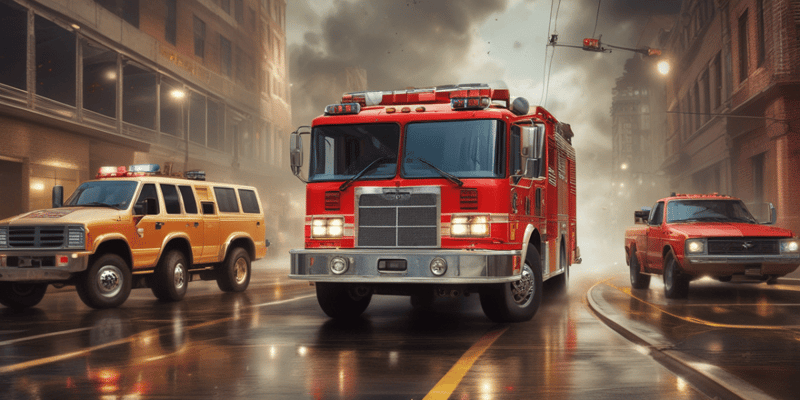Questions and Answers
What is a significant danger associated with sealed cylinders and containers in vehicle fires?
Which material in modern vehicles often results in more toxic smoke/gasses than building fires?
Which type of vehicle fuel system is associated with the potential for BLEVE?
After disconnecting the battery, how long can airbags remain charged?
Signup and view all the answers
Which item has NOT been mentioned as a potential projectile due to over-pressurization in vehicle fires?
Signup and view all the answers
What is the primary reason that firefighters should avoid cutting large, orange-colored electric cables on electric/hybrid vehicles?
Signup and view all the answers
What hazard does the smoke from burning plastics in vehicle fires pose to firefighters?
Signup and view all the answers
Which component of vehicle fires might require additional Hazmat considerations?
Signup and view all the answers
Why might a firefighter be injured by an airbag in a vehicle fire scenario?
Signup and view all the answers
Study Notes
Vehicle Fires: Dangers and Precautions
Sealed Cylinders/Containers
- Over-pressurization due to heat exposure can cause projectiles to fly, resulting in penetrating injuries and fractures
- Examples of sealed cylinders/containers include shocks, struts, shock absorbing bumper mounts, drive shafts, and gas-charged hood supports
Plastics in Modern Vehicles
- Modern vehicles are made of more than 50% plastic
- Smoke and gases from vehicle fires are often more toxic than those found in building fires
Fuel Systems
- Vehicles can be fueled by gasoline, diesel, propane, compressed natural gas, liquefied natural gas, batteries/hybrid, and others
- Gasoline tanks can rupture due to over-pressurization from heat exposure
- Propane, CNG, and LNG cylinders can BLEVE (boiling liquid expanding vapor explosion)
- Batteries from hybrids have additional Hazmat considerations
- Firefighters should not cut the large, orange-colored electric cables on electric/hybrid vehicles
Airbags
- Airbags remain activated and charged via a capacitor
- Airbags can remain charged from 30 seconds up to several minutes after the battery is disconnected
- Firefighters in front of a discharging airbag are likely to be injured
Studying That Suits You
Use AI to generate personalized quizzes and flashcards to suit your learning preferences.
Description
This quiz covers the hazards and safety measures related to vehicle fires, including the risks associated with sealed cylinders and containers. Learn how to prevent injuries and respond to emergency situations.




